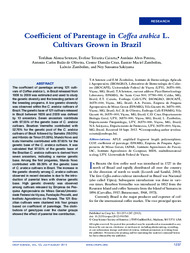Coefficient of parentage in Coffea arabica L. cultivars grown in Brazil.
Coefficient of parentage in Coffea arabica L. cultivars grown in Brazil.
Author(s): SETOTAW, T. A.; CAIXETA, E. T.; PEREIRA, A. A.; OLIVEIRA, A. C. B. de; CRUZ, C. D.; ZAMBOLIM, E. M.; ZAMBOLIM, L.; SAKIYAMA, N. S.
Summary: The coefficient of parentage among 121 cultivars of Coffea arabica L. in Brazil released from 1939 to 2009 was estimated and used to study the genetic diversity and the breeding pattern of the breeding programs. A low genetic diversity was observed within the C. arabica cultivars of Brazil. The genetic base of 121 cultivars released in Brazil between 1939 and 2009 was defined by 13 ancestors. Seven ancestors contribute with 97.55% of the genetic base of C. arabica cultivars. Bourbon Vermelho contributed with 52.76% for the genetic pool of the C. arabica cultivars of Brazil followed by Sumatra (19.05%) and Híbrido de Timor (11.59%). Mundo Novo and Icatu Vermelho contributed with 87.65% for the genetic base of the C. arabica cultivars. It was calculated that 97.55% of the genetic base of the Brazilian C. arabica cultivars is derived from seven ancestors, indicating a narrow genetic base. Among the first progenies, Mundo Novo contributed with 69.39% of the genetic base of C. arabica cultivars in Brazil. The increase in the genetic diversity among C. arabica cultivars observed in recent decades is due to the introduction of parental lines with diverse genetic base. High genetic diversity was observed among cultivars released by Empresa de Pesquisa Agropecuária de Minas Gerais/Universidade Federal de Viçosa, Fundação Procafé, and Instituto Agronômico do Paraná. The 121 Brazilian cultivars were clustered into four groups based on coefficient of parentage. The distributions of genotypes over the cluster groups showed the effect of parental line contribution.
Publication year: 2013
Types of publication: Journal article
Unit: Embrapa Coffee
Keywords: Coffea Arábica
Observation
Some of Embrapa's publications are published as ePub files. To read them, use or download one of the following free software options to your computer or mobile device. Android: Google Play Books; IOS: iBooks; Windows and Linux: Calibre.
Access other publications
Access the Agricultural Research Database (BDPA) to consult Embrapa's full library collection and records.
Visit Embrapa Bookstore to purchase books and other publications sold by Embrapa.

